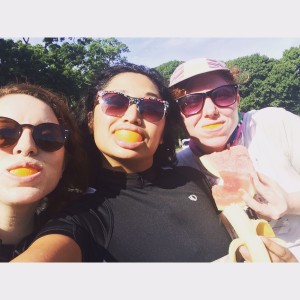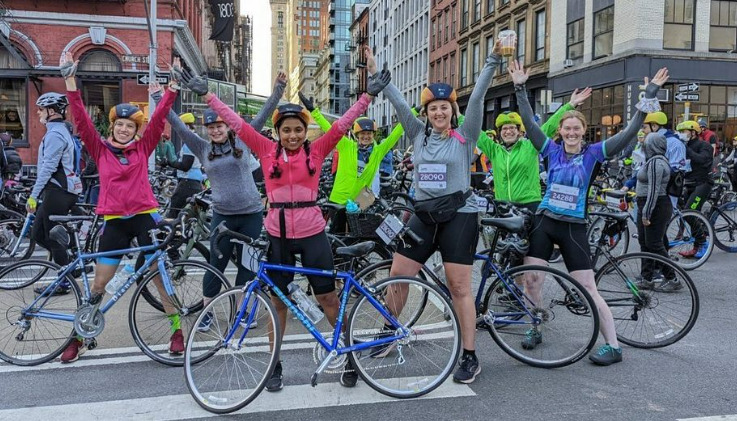Today is the official kick-off to National Bike Month and the 2015 season. Now that the trees are budding, the flowers are blooming and the days are longer New Yorkers are beginning to crawl out from underground and emerge from hibernating in their apartments all winter. Looking to enjoy the weather and improve your mood by commuting to work? Wondering what you’ll need to pack for your commute? WE Bike NYCer Elyse Bejasa asked some women to share their tricks and tips for commuting to work – thanks Elyse!
Commuting By Bike: What to Pack?
My commute to work is one of my favorite parts of the day. I’m outside on my bike, enjoying the city on two wheels, getting some exercise, and not spending $2.75 to get stuck between stations or hear that there’s a train two stations away (is this ever true?). But one of the most cumbersome parts of bike commuting is knowing what to pack. Overpack and you’re riding with an unnecessarily heavy load. Underpack and you might get stuck in a situation where you don’t have what you need. What’s a commuter to do?
WE asked a few WE Bike NYC commuters to share what they pack on their commutes and tips to keep in mind when packing.
THE STANDARD
Change of clothes for work: Most of us work in environments where bike/workout clothes aren’t work appropriate, so we either bring a change with us or have clothes already at our offices. Socks, underwear, and bras also get packed when we think we might need a change when we get to work.
Baby wipes and deodorant: Depending on the length of your commute and the weather outside, you may get to work sweatier than you’d like to be. If you don’t have access to a shower, these help freshen you up so people won’t mind sitting next to you during meetings.
“Bike bag”: We all kinda-sorta carry some sort of bike bag. Usual contents include: tire levers, extra tube, bike lights (if they’re not already mounted to your bike), small pump/CO2 tube, patch kit. Whether it’s in our bags, on our bikes, or wherever, these things can come in hand on your commute when you least expect it. Most shops aren’t open in time for the morning commute so it’s great to have these things accessible if you don’t have time to wait for the nearest shop to open. But if you do find yourself in a bind, you can always locate a BikeStock vending machine and get what you need to keep going.
Lunch and snacks: A long commute can lead to a hungry (read: CRANKY) cyclist. Keeping snacks in your bag can help alleviate that (bars like CLIF, Kind, etc.). Nuun tablets during the summer help re-hydrate after a sweaty commute. If you bring your lunch to work (like me!), remember that it can take up a fair chunk of space in your bag, so if you’re buying a commuter bag, keep this in mind.
Bike lock: Most of us are lucky to get indoor bike parking in our buildings, but even so, it’s always a good idea to carry a lock. You never know when you’re going to need it.
Etcetera: Medicine/makeup bag (includes things like Chapstick with SPF, face and/or hand lotion, and sunscreen); essentials (wallet, phone, keys); phone chargers, headphones.
SOME TIPS
- If you find yourself switching between bags pretty often, keep things in separate pouches so it’s easier to transfer between bags.
- Leave things like extra lotion, baby wipes, deodorant, etc. at your desk as necessary.
- If you have a rear or front rack, consider riding with panniers or with a bag strapped to your rack by bungee cords.
ELYSE

THE COMMUTE: 8 miles, Crown Heights to Chelsea
THE JOB: Fundraising at a nonprofit
THE BAG: Timbuk2 Custom Commute Laptop Messenger Bag. I love this bag because it is pretty large (and can expand as necessary), has plenty of pockets for keeping things organized (including an exterior pocket on the side for easy access), is weatherproof, and was designed with commuters in mind. Having a big bag also means I don’t necessarily have to eliminate things when I’m deciding on what to pack and I like to be prepared for anything. I also chose bright yellow to help with visibility.
ELIZABETH

THE COMMUTE: 9 miles, Murray Hill to Washington Heights
I am not an everyday rider, but I am working my way to more frequent commutes. I don’t mind cold, just ice, so that inhibits me. Several times a week and I’m happy. Would be nice to eliminate the MTA completely, but it’s not a reality for many reasons.
THE JOB: Public Librarian
THE BAG: When I had a folder bike I used Ortlieb panniers, but much of what I carried then I just leave at work now, so just use a simple, light non-bike specific Nike backpack.
During the summer, on rare occasions, I can travel with a jersey and just squeeze my keys, phone cables, change of sports bra/underwear into a large bottle and put them on the bottle rack. Sounds gross to put clothes in a bottle, but only when they are clean. I sometimes leave them at work until a back pack day or train day. I have a full wardrobe of old clothes at work along with soap, wash cloth and towel and toiletries in my locker and desk drawer.
EVO

THE COMMUTE: 4.5-5 miles, Park Slope to Lower Manhattan
THE JOB: Trading at a mid-size firm
THE BAG: I carry less and less because I hate carrying all that stuff on my back. Sometimes I even leave my clothes at work and just wear the same thing for several days at a time, and just switch out my bike clothing at home for washing. No one notices.
I use a messenger bag or a small backpack. I tried using a hiking pack once and that wasn’t good – the top of the pack (which was hard to keep the pack rigid) kept hitting the back of my helmet and made for a very uncomfortable ride. The messenger bag (once I got used to it) is nice because it can fit a lot if I need it to. Even so, I’m always on the lookout for more back-ventilation friendly bags.
MEG

THE COMMUTE: 10 miles, Washington Heights to TriBeCa
THE JOB: Due Diligence and Strategic Research
THE BAG: One Ortlieb Back-Roller Classic Pannier. Carrying anything on my back while I bike quickly brings on lower back pain, so I love having panniers for my bicycle racks. My Ortliebs are completely waterproof so if I decide to commute in the rain, I know all of my things inside won’t get wet. Also, one pannier is 20 liters, so it can hold a lot! I carry all the essentials for a simple bike fix, lock and lights. I also bring a change of clothes, a makeup bag, and breakfast/lunch. When packing up my pannier, I use tote bags to keep my clothes separate from things like my wallet, daily planner, etc. That way when I arrive to work I know that one tote has everything I need to get ready and I can leave the other stuff at my desk. I’m lucky to have a shower at my company so I keep things like a hair dryer, hair brush, shampoo and conditioner all at my desk.
COURTNEY

THE COMMUTE: 16 miles, Clinton Hill, Brooklyn to Fordham, The Bronx
THE JOB: Business Advisor
THE BAG: Avon tote bag attached to my back rack with bungee cords from the discount store. I’ve actually had the bag for years but have recently fallen in love with it because it exactly matches my Torch illuminated helmet (I like to coordinate).
On this day, I actually took my bike on the train because I wanted to ride home from work in the good weather. Because of the distance (and three bridges), the economy of weight and bulk is especially important for me. So on bike-to-and-from-work days, I have to carefully choose my professional clothes for the day. I try to choose work outfits that are loose or stretchy (like a body con dress under a simple black skirt) to avoid winkles, and bike outfits with thin but effective layers so that they fit in the bag with my helmet, lunch, Kindle, and essential equipment. Chargers are also a must because I am still trying out new routes and cannot afford to run out of juice for my Google maps 3 boroughs from home!
—
Despite our different routes, jobs, and gear, WE all agree that getting to work by bike is the best way to commute! Ride safe!















